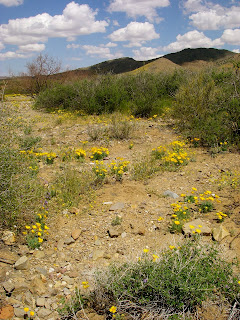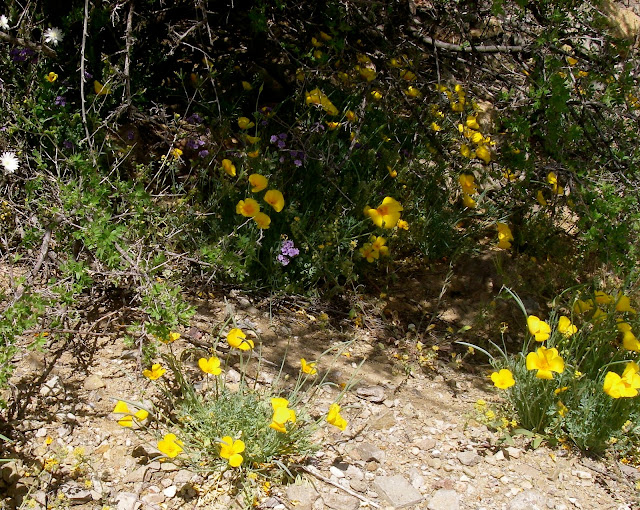Continuing the story of our trip to the bootheel region of New Mexico in early April 2010, after leaving the town of Gila, we headed south through Silver City. There we enjoyed a picnic lunch in their Central Park. It was a mellow scene, reminiscent of my childhood in the 50's. Families played badmitton, teens lollygagged...is that a word? After eating we headed south, through down-at-the-heels Lordsburg (the only lords are reputedly of the drug type) in search of an odd rock formation I'd discovered on Google Earth. The photo was entitled "Gaia's Brain". If you look in the New Mexico boot heel area carefully, you will probably find it, just make sure Panoramio is enabled.

We found the dirt road I'd aimed for, which heads due south from Lordsburg. However, there were absolutely no road numbers marked, so I was at a loss as to how to locate the spot I'd hoped to find. Without GPS capability, we never did discover Gaia's Brain. It didn't really matter. We had moved into a warmer region, and were beginning to see flowers.
The first blossoms I photographed were Spectacle Pod (Dimorphocarpa wislizeni), a particularly elegant wildflower easily identified by its distinctive two-seeded pod which resembled eyeglasses.
Close up of Spectacle Pod, a delicate beauty in the harsh desert.
Nearby I discovered a very prostrate variety of Scorpionflwer, probably Phacelia arizonica, growing beside the road.
Phacelia arizonica, revealing the enticing blossoms.
Soon we were seeing a particularly showy, tall white-flowered plant, which grew in the shelter of creosote bushes. I didn't expect to have any trouble identifying it, but later I learned to my chagrin that Desert Chicory and White Tackstem are nearly identical if you just look at the flowers. I'm guessing that this is Desert Chicory (Rafinesquia neomexicana), which is very widespread, and has slightly fewer petals than its look-alike. White Tackstem (Calycoseris wrightii) has a milky sap and tack-like glands on the stem. Unfortunately, my photos don't reveal these distinctive characteristics! If you can tell which it is, please let me know. Whichever it is, it's a beautiful, showy flower which was blooming everywhere from that point on through SE Arizona.
In the same area I spotted this Yellow Fiddleneck (Amsinckia tesselata). Like Scorpionflower, Fiddleneck blooms unfurl from a tight spiral, hence the common names.
Nearby were many specimens of another beautiful scorpionflower species: Phacelia distans. Please note that my identification of all these plants is based on research, not experience. Most of them were brand new to me. Again, if you know I have made a mistake in an ID, please let me know and I will change it.
Thinking I'd see more, and with Steve waiting rather impatiently in the car with the two dogs, I hurriedly snapped this shot of Morning Bride or Desert pincushion
(Chaenactis stevioides) which was waving in the wind. I never saw another specimen, so must apologetically post this slightly blurry photo. This plant was part of a community of about seven different kinds of flowers, all in bloom at once, clustered in the shade of a creosote bush.
Now we began to see Mexican Goldpoppies (Escholtzia californica ssp. mexicana), which cloaked the hills with a golden blanket. These are nearly identical to the Californis poppies with which I grew up, but are more yellow than orange, and a little smaller. We decided to let the restive dogs out and take a short hike into the desert.
It was quickly obvious that the plants preferred to grow under the mesquite and creosote, where they had some protection from the extremes of the desert climate.
We could see the mountains of Southern Arizona across the flat plain of what was once a great lake bed. Flowers were abundant after a wet winter.
The cloud cover kept the sun from being too intense. It was a perfect day, but I wouldn't want to try this in the summer!
Here's another example of a plant guild: Mexican poppies, desert chicory and scorpionweed all enjoying one another's company.
Another elegant wildflower: Gordon's bladderpod (Lesquerella gordonii).
We sat for a bit in the shade of a huge old Juniperus monosperma, the ubiquitous "Cedron" of New Mexico.
Mexican Goldpoppies & Desert Dandelions
Desert dandelion ( Malacothrix californica var. glabrata).
This is a young flower; mature flowers form a red dot in center. It's easy to see how this got its common name! As we walked back to the car to continue our trip into southern Arizona, I thanked my lucky stars that we had jumped on this opportunity to see the desert in bloom.
In my next post I will take you into the amazing Chiracahua Mountains of Southeastern Arizona.

















































